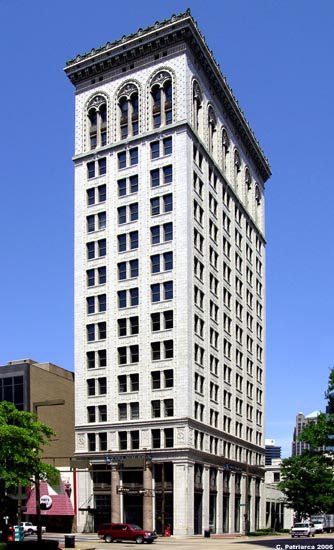Empire Building
- This article is about the 16-story downtown tower. For other uses, see Empire Building (disambiguation).
The Empire Building is a 16-story, 247 foot tall classical revival style skyscraper at 1928 1st Avenue North on the northwest corner of its intersection with 20th Street. It was erected on the former site of the Bank Saloon in 1909. When it was built, it was the tallest building in Alabama. Within four years that honor was passed to the American Trust and Savings Bank Building on the opposite corner, creating what became known as the Heaviest Corner on Earth.
The Empire Building was developed by the Empire Improvement Company, which was headed by Robert Jemison Sr. The construction was financed in part by a mortgage loan from the Metropolitan Life Insurance Company, the first such deal made by an insurer for development.
Though local architects William T. Warren and William Leslie Welton are usually credited with the design, it is more likely that J. E. R. Carpenter of the New York firm of Carpenter & Blair acted as the lead designer with Warren & Welton, young architects who arrived in Birmingham in 1907, as associates supervising the details of construction. (Alexander-1986) There were 19 bidders for the construction contract, which was eventually awarded to the Thompson–Starrett Co. of New York, represented locally by superintendent Frederick Larkin.
The entire facade is executed in molded terra-cotta. The 1st Avenue entrance is flanked by monumental pink granite Doric columns. The arched niches above the paired windows in the upper story feature sculpted busts of allegorical figures. Larkin (as Frederick the Great) and Welton (as Emperor William) appear among them. The elaborate and colorful cornice features a repeating shield motif of large white capital "E"s, representing the developer. Interior finishes included Italian marble and mahogany. Services included in the building when it opened included hot and cold running water and a central vacuum system.
The construction period was documented in monthly photographs by the Birmingham View Company. The foundations had been set by January 15, 1909. Union ironworkers from Local 92 provided skilled labor for the building's 50' x 100' x 192' steel frame, which was completed in 23 days. The first column of the 16th floor was in place in mid-March. By May 15 the terra-cotta cladding was installed, and a month later visible construction was nearing an end. Harry Lesher was appointed building manager in 1911.
On January 30, 1917 a crowd of thousands assembled in the streets to witness Harry "The Human Fly" Gardiner climbing the exterior of the Empire Building. A photograph from the event shows a Greene Drug Company, a Rexall-affiliated pharmacy, occupying the ground-floor corner location, Richter Co. Tailers on the third-floor, and the offices of the Birmingham Motor Speedway Company on the fourth floor. A 1934 ad claims that the Birmingham Firemen's Relief Association located in the Empire Building because of its convenience.
In the 1950s a illuminated sign for Buffalo Rock was located on the roof of the building.
In 1964 the building was purchased and renovated for the newly-formed City National Bank, who renamed it the City National Bank Building. Their remodeled offices opened on January 18, 1965.
In 1982 the Empire Building was added to the National Register of Historic Places. Until the demise of Colonial Bank in 2009, the financial institution had a branch on the ground floor of the building. With its closing the tower became vacant.
| Preceded by: Bank Saloon |
1928 1st Avenue North 1909 - present |
Succeeded by: current |
Hotel conversion
In 2012 investor John Tampa of Georgia-based Ascent Hospitality purchased the building, with the intent of redeveloping it as a boutique hotel. Financing opportunities instead led him to propose low-income apartments for the property. In November 2014 the website of New Orleans, Louisiana architects John T. Campo & Associates, suggested that the building would be converted into a Marriott Autograph Hotel. That suggestion was confirmed in April 2015 with Ascent's announcement of a 117-room luxury hotel in the Empire and a 120-room limited-service Marriott hotel in the nearby Alagasco Building. A new restaurant for the project is being developed by chef Chris Hastings.
Tenants
References
- "Cyrus Johnson Swings Around the Circle and Writes Entertainingly of Architects and Contractors" (October 1908) The Realty Record and Builder. Vol 15, No. 10, p. 7
- Alexander, James Rodger. (1986) Terra Cotta Facades of Birmingham Architecture. Exhibition catalog. Birmingham: UAB Visual Arts Gallery
- Jefferson County Historical Commission. (1998) Birmingham and Jefferson County, Alabama Images of America Series. Charleston, SC: Arcadia Publishing ISBN 0752413465
- Lewis, Pierce. (1996) Birmingham View: Through the Years in Photographs Birmingham: Birmingham Historical Society ISBN 0943994217
- Satterfield, Carolyn Green. (1976) Historic Sites of Jefferson County, Alabama. Prepared for the Jefferson County Historical Commission. Birmingham: Gray Printing Co.
- White, Marjorie Longenecker, ed. (1977) Downtown Birmiingham: Architectural and Historical Walking Tour Guide. Birmingham: Birmingham Historical Society
- "Timepiece" (January 2007) Birmingham Magazine
- Poe, Ryan (October 19, 2012) "New owner plans low-income apartments for Empire Building." Birmingham Business Journal
- Davis, Bryan (November 21, 2014) "Empire Building could become Marriott Autograph Collection hotel." Birmingham Business Journal
- Gray, Jeremy (April 13, 2015) "Empire Building part of $45 million project including two Marriotts, new Chris Hastings restaurant." The Birmingham News
External links
- Empire Building on Emporis.com
- 3-D model of the Empire Building by Jordan Herring

